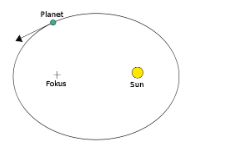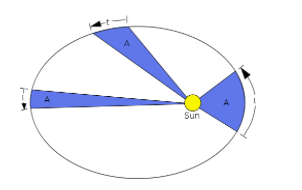
Describe Kepler’s law of planetary motion?
Answer
472.8k+ views
Hint:This is a pretty straightforward question, asking about Kepler’s law of planetary motion. If you are having trouble recalling Kepler's law, let us help by telling you that there are three Kepler’s laws, one of them says that planets orbit around the Sun in an elliptical path instead of circular. You can try to recall the other two laws now.
Complete step by step answer:
In the early 1600s, Johannes Kepler proposed three laws of planetary motion. Kepler did so by being able to summarize the carefully collected data of his mentor, Tycho Brahe, with three laws or statements that described the motion of planets in a solar system centered around the Sun. Even after this long time and technological advancements, Kepler's laws are still considered to be an accurate description of the motion of any planet and any satellite.
Kepler's three laws of planetary motion can be described as follows:
The Law of Ellipses: The path of the planets about the sun is elliptical in shape, with the center of the sun being located at one focus.

The Law of Equal Areas: An imaginary line drawn from the center of the sun to the center of the planet will sweep out equal areas in equal intervals of time.

The Law of Harmonies: The ratio of the squares of the periods of any two planets is equal to the ratio of the cubes of their average distances from the sun.
Note:To make your answer more attractive, you can include the diagrams and mathematical equations along with the statements of the Kepler’s laws, but that is unnecessary for now, maybe only try to do that if you have extra time remaining before the clock runs out in the exam.
Complete step by step answer:
In the early 1600s, Johannes Kepler proposed three laws of planetary motion. Kepler did so by being able to summarize the carefully collected data of his mentor, Tycho Brahe, with three laws or statements that described the motion of planets in a solar system centered around the Sun. Even after this long time and technological advancements, Kepler's laws are still considered to be an accurate description of the motion of any planet and any satellite.
Kepler's three laws of planetary motion can be described as follows:
The Law of Ellipses: The path of the planets about the sun is elliptical in shape, with the center of the sun being located at one focus.

The Law of Equal Areas: An imaginary line drawn from the center of the sun to the center of the planet will sweep out equal areas in equal intervals of time.

The Law of Harmonies: The ratio of the squares of the periods of any two planets is equal to the ratio of the cubes of their average distances from the sun.
Note:To make your answer more attractive, you can include the diagrams and mathematical equations along with the statements of the Kepler’s laws, but that is unnecessary for now, maybe only try to do that if you have extra time remaining before the clock runs out in the exam.
Recently Updated Pages
Master Class 12 Social Science: Engaging Questions & Answers for Success

Class 12 Question and Answer - Your Ultimate Solutions Guide

Class 10 Question and Answer - Your Ultimate Solutions Guide

Master Class 10 Science: Engaging Questions & Answers for Success

Master Class 10 Maths: Engaging Questions & Answers for Success

Master Class 9 General Knowledge: Engaging Questions & Answers for Success

Trending doubts
Is Cellular respiration an Oxidation or Reduction class 11 chemistry CBSE

In electron dot structure the valence shell electrons class 11 chemistry CBSE

What is the Pitti Island famous for ABird Sanctuary class 11 social science CBSE

State the laws of reflection of light

One Metric ton is equal to kg A 10000 B 1000 C 100 class 11 physics CBSE

Difference Between Prokaryotic Cells and Eukaryotic Cells




